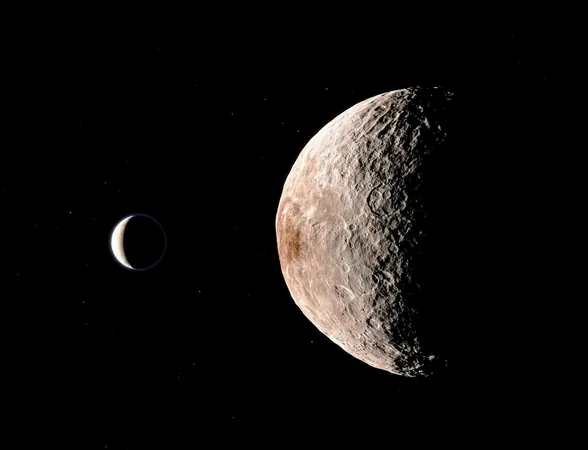
Shocking New Research Reveals How Pluto and Charon Became a Cosmic Couple!
2025-01-11
Author: Siti
A New Perspective on Pluto and Charon's Formation
In the distant reaches of our solar system, billions of years ago, a celestial event unfolded that would forever define the relationship between Pluto and its largest moon, Charon. Rather than a catastrophic collision that destroyed everything in its path, these two icy bodies engaged in what scientists have whimsically dubbed a "kiss and capture" interaction—a scientific revelation that is reshaping our understanding of planetary formation.
Groundbreaking Study
A groundbreaking study led by Adeene Denton, a NASA postdoctoral fellow at the University of Arizona's Lunar and Planetary Laboratory, has shaken up previous theories about how these two frozen worlds came to be. Denton and her team discovered that their unique characteristics—small size, cold temperatures, and composition primarily made of rock and ice—played a crucial role in this cosmic pairing.
Rethinking Moon Formation
For decades, researchers believed that Charon’s formation was akin to that of Earth’s moon, resulting from a colossal impact that caused fluid-like deformation. Such models were effective for larger, hotter bodies where materials could flow and reshape. However, Pluto and Charon’s cold, rigid structure demanded a fresh perspective.
Simulations Reveal 'Kiss and Capture'
Through advanced computer simulations, the research team demonstrated that when Pluto and a proto-Charon collided, they did not resemble molten materials. Instead, they temporarily adhered to each other, forming a snowman-like structure before eventually separating, yet remaining gravitationally bound. This "kiss and capture" mechanism not only establishes their current binary status but also provides an intriguing alternative to traditional moon formation theories.
Significant Implications
Most models categorize such cosmic events as "hit and run" or "graze and merge." However, the team's discovery of this unique "kiss and capture" scenario poses a significant shift, accurately placing Charon in a stable orbit around Pluto—an observation that aligns perfectly with current data.
Preservation of Celestial Bodies
Moreover, the study indicated that the collision preserved the integrity of both celestial bodies, contradicting earlier theories that speculated extensive mixing and deformation. Remarkably, the impact generated tidal forces that heated both Pluto and Charon, potentially allowing Pluto to develop a subterranean ocean without necessitating the more chaotic conditions thought to exist in the early solar system.
Future Research Directions
As scientific interest grows, researchers also aim to explore whether similar "kiss and capture" mechanics might apply to other binary systems scattered throughout the universe.
Final Thoughts
Ultimately, this study, published in the journal Nature Geoscience, not only redefines the origin story of Pluto and Charon but also challenges traditional perspectives on planetary system formation. As we delve deeper into these cosmic mechanics, we may uncover vital insights into how various celestial bodies evolve, paving the way to unlocking further mysteries of our solar system and beyond.
Stay Tuned!
Stay tuned for more revelations and subscribe to our newsletter for the latest cosmic explorations!

 Brasil (PT)
Brasil (PT)
 Canada (EN)
Canada (EN)
 Chile (ES)
Chile (ES)
 Česko (CS)
Česko (CS)
 대한민국 (KO)
대한민국 (KO)
 España (ES)
España (ES)
 France (FR)
France (FR)
 Hong Kong (EN)
Hong Kong (EN)
 Italia (IT)
Italia (IT)
 日本 (JA)
日本 (JA)
 Magyarország (HU)
Magyarország (HU)
 Norge (NO)
Norge (NO)
 Polska (PL)
Polska (PL)
 Schweiz (DE)
Schweiz (DE)
 Singapore (EN)
Singapore (EN)
 Sverige (SV)
Sverige (SV)
 Suomi (FI)
Suomi (FI)
 Türkiye (TR)
Türkiye (TR)
 الإمارات العربية المتحدة (AR)
الإمارات العربية المتحدة (AR)